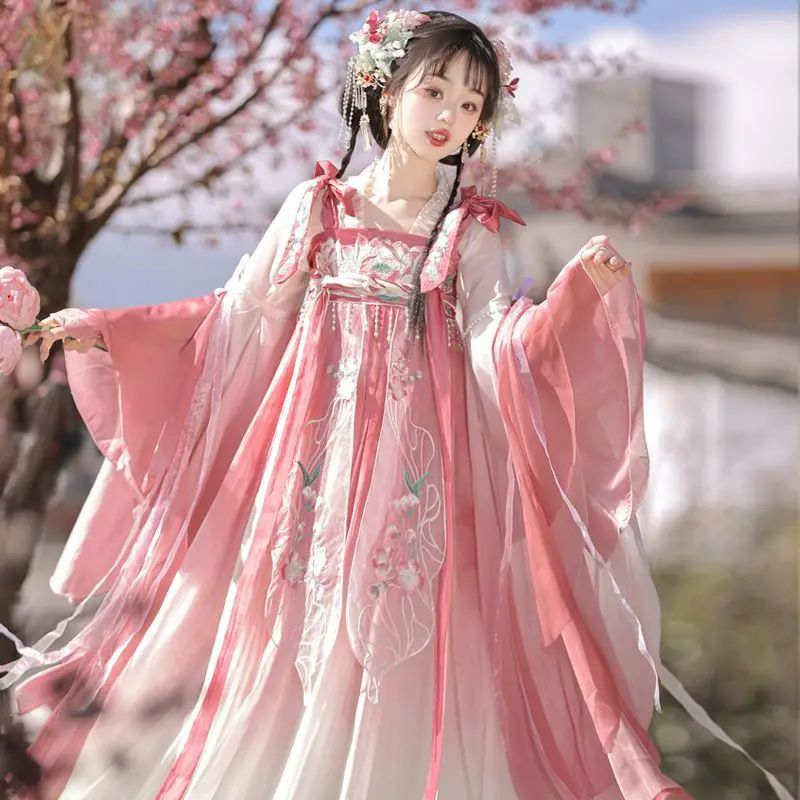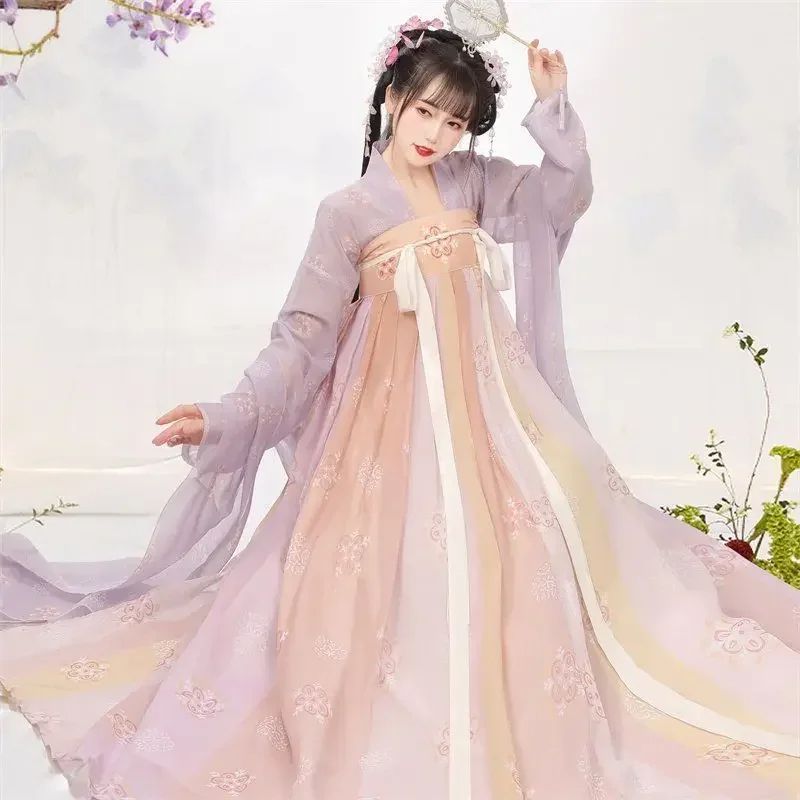The Art of Silk Weaving: Exploring the Intricate Techniques of Tang Hanfu
Tang Hanfu, the exquisite garments of the Tang Dynasty, embody the pinnacle of Chinese craftsmanship. Their intricate designs and luxurious fabrics are a testament to the skill and artistry of the artisans who created them.

Silk Weaving: The Foundation of Tang Hanfu
At the heart of Tang Hanfu lies the art of silk weaving. The finest silk, known as “jiangnan silk,” was produced in the fertile regions of southern China. Skilled weavers employed various techniques to create the intricate patterns and textures that adorned these garments.
One such technique was “jin,” where supplementary threads were woven into the fabric to create raised designs. Another was “ke,” where threads were cut and reattached to form intricate patterns. The resulting fabrics were not only visually stunning but also incredibly durable.
Embroidery: Enhancing Beauty and Symbolism
Embroidery played a vital role in embellishing Tang Hanfu. Artisans used a variety of stitches and threads to create intricate designs that conveyed both beauty and symbolism. Flowers, birds, and auspicious motifs were commonly depicted, representing prosperity, longevity, and harmony.
Dyeing: A Symphony of Colors
The vibrant colors of Tang Hanfu were achieved through a complex dyeing process. Natural dyes derived from plants, minerals, and insects were used to create a wide range of hues. The most prized color was “zhu,” a deep red that symbolized wealth and power.
Artisans: The Keepers of Tradition
Behind the exquisite garments of Tang Hanfu were skilled artisans who dedicated their lives to preserving and passing down these ancient techniques. They were highly respected members of society, and their work was considered a form of high art.
Today, the craftsmanship behind Tang Hanfu continues to be celebrated and preserved. Master artisans work tirelessly to maintain the traditions of their ancestors, ensuring that the beauty and artistry of these garments will endure for generations to come.
Conclusione
In conclusion, Tang Hanfu is a testament to the extraordinary craftsmanship of the Tang Dynasty. The intricate techniques of silk weaving, embroidery, and dyeing, combined with the skill and dedication of artisans, created garments that were not only visually stunning but also imbued with cultural significance. As we appreciate the beauty of these traditional garments, we honor the legacy of the artisans who brought them to life.
The Skill of Embroidery: Unraveling the Delicate Craftsmanship of Tang Hanfu
Tang Hanfu, the exquisite attire of the Tang Dynasty, embodies the pinnacle of Chinese craftsmanship. Among its many intricate elements, embroidery stands out as a testament to the skill and artistry of its creators.
Embroidery in Tang Hanfu is not merely a decorative embellishment; it is an integral part of the garment’s design and symbolism. Each stitch carries a story, conveying the wearer’s status, aspirations, and cultural heritage. The techniques employed in Tang Hanfu embroidery are as diverse as they are intricate.

Iconic Techniques
One of the most iconic techniques is the “needle-painting” method. Using fine silk threads, artisans meticulously recreate scenes from nature, mythology, and everyday life. The resulting embroideries are breathtakingly realistic, capturing the essence of the subject matter with astonishing detail.
Another technique, known as “gold-thread embroidery,” involves the use of gold-wrapped threads to create shimmering and opulent designs. These threads are often combined with pearls and gemstones to enhance the garment’s grandeur.
Dedicated Artisans
The artisans who create Tang Hanfu embroidery are highly skilled and dedicated. They undergo years of training to master the intricate techniques and develop the patience and precision required for this delicate craft.
The process of creating a single embroidered garment can take months or even years. Each stitch is carefully placed, with the artisan paying meticulous attention to the tension and direction of the thread. The result is a work of art that is both beautiful and enduring.
Importanza culturale
The craftsmanship behind Tang Hanfu embroidery is not only a testament to the skill of its artisans but also a reflection of the cultural significance of these garments. They are not merely clothing but symbols of tradition, artistry, and the enduring legacy of Chinese craftsmanship.
Today, the art of Tang Hanfu embroidery continues to be practiced by a dedicated group of artisans who are committed to preserving this ancient tradition. Their work ensures that the beauty and symbolism of Tang Hanfu will continue to inspire and captivate generations to come.
The Mastery of Dyeing: Unveiling the Vibrant Colors of Tang Hanfu
The vibrant hues that adorn Tang Hanfu, the traditional garments of the Tang Dynasty, are a testament to the exceptional craftsmanship of its artisans. Dyeing, a crucial aspect of Hanfu creation, played a pivotal role in imbuing these garments with their captivating colors.

Flourishing Techniques
The Tang Dynasty witnessed a flourishing of dyeing techniques, with artisans employing a wide range of natural dyes derived from plants, minerals, and insects. Indigo, extracted from the leaves of the indigo plant, was widely used to create deep blue hues. Madder root yielded vibrant reds, while saffron and turmeric provided golden yellows.
Meticulous Process
The dyeing process was meticulous and time-consuming. Fabrics were first soaked in a mordant, a substance that helped the dye adhere to the fibers. The mordant could be made from alum, vinegar, or other natural materials. The fabric was then immersed in the dye bath, which was carefully controlled to achieve the desired color intensity.
Artisan Knowledge
Artisans possessed an intimate knowledge of the properties of each dye and the effects of different mordants. They experimented with various combinations to create a vast array of colors, from subtle pastels to bold primaries. The use of multiple dyes in a single garment resulted in intricate patterns and color gradations.
Artistic Expression
The dyeing of Tang Hanfu was not merely a technical process but also an art form. Artisans took pride in their work, striving to achieve the perfect balance of color and design. The vibrant hues of Tang Hanfu not only enhanced their aesthetic appeal but also conveyed social status and cultural significance.
Conclusione
The mastery of dyeing in Tang Hanfu is a testament to the exceptional skills and artistry of its artisans. Their techniques have been passed down through generations, ensuring that the vibrant colors of Tang Hanfu continue to captivate and inspire. Today, these traditional dyeing methods are still employed by skilled artisans, preserving the rich cultural heritage of this iconic garment.
